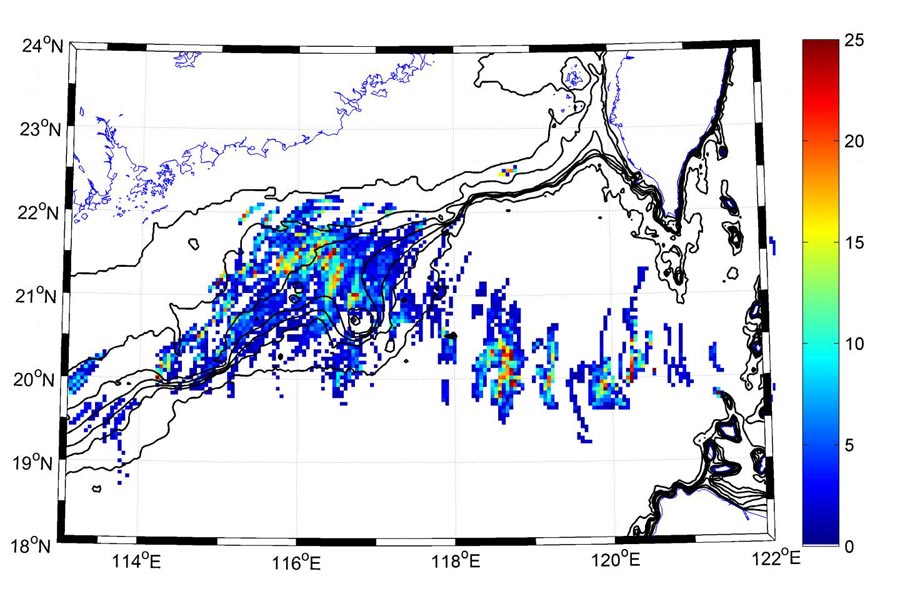

The density map covering the South China Sea from Luzon Strait (right side) the 'Generation Area' to Dongsha Island (left side) shows how prolific these internal waves occur in this region and where they are most visible. The wave packets travel east to west. The color denotes how frequently an internal wave was observed in satellite images over a several month period in 2007.
Credit: CSTARS
A scientific research team spent seven years tracking the movements of skyscraper-high waves in the South China Sea. University of Miami (UM) Rosenstiel School of Marine and Atmospheric Science scientists were part of the collaborative international field study trying to understand how these waves, which rarely break the ocean surface, develop, move and dissipate underwater.
These waves, known as internal waves, occur in all the oceans, as well as in lakes and fjords. In the Luzon Strait, between Taiwan and the Philippine island of Luzon, they can reach up to 170 meters (558 feet) tall and travel several hundred kilometers, making them some of the largest waves in the world.
Using satellite imagery collected at UM's Center for Southeastern Tropical Remote Sensing (CSTARS), scientists were able to detect and track them from above.
The team discovered that internal waves are generated daily from internal tides, which also occur below the ocean surface, and grow larger as the water is pushed westward through the Luzon Strait into the South China Sea.
“The internal wave produces a current that organizes the ripples on the surface, which are picked up by the radar satellite,” said study co-author Hans Graber, a UM Rosenstiel School professor of ocean sciences and director of CSTARS. “This allows us to study how these waves, which largely go unnoticed at the surface, propagate and move.”
Tracking internal waves from start to finish helps scientists understand these waves for a number of reasons. They move huge volumes of heat, salt, and nutrient rich-water, which are important to fish, industrial fishing operations and the global climate. In addition, they are important to monitor for safe submarine operations.
###
The team published the study, titled “The formation and fate of internal waves in the South China Sea,” in the May 7 issue of the journal Nature. The U.S. Office of Naval Research and the Taiwan National Science Council funded the study.
About the University of Miami's Rosenstiel School
The University of Miami is one of the largest private research institutions in the southeastern United States. The University's mission is to provide quality education, attract and retain outstanding students, support the faculty and their research, and build an endowment for University initiatives. Founded in the 1940's, the Rosenstiel School of Marine & Atmospheric Science has grown into one of the world's premier marine and atmospheric research institutions. Offering dynamic interdisciplinary academics, the Rosenstiel School is dedicated to helping communities to better understand the planet, participating in the establishment of environmental policies, and aiding in the improvement of society and quality of life. For more information, visit: http://www.











